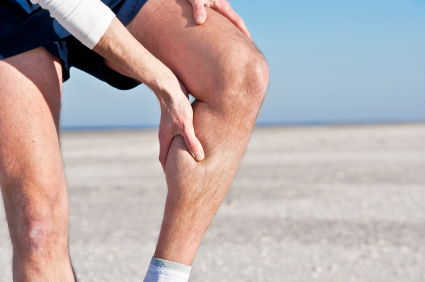Muscle Bleeds in the Arms and Legs
 Bleeding into the muscles in the arms, legs, and thighs can occur in people with hemophilia and other severe bleeding disorders. The bleeding can start after the muscle is hit, is sprained, or you get a shot in the muscle. With severe hemophilia, it can also happen for no clear reason (called a "spontaneous" bleed). Muscle bleeds can cause a lot of blood loss inside your body. As the blood builds up inside, it can press against nerves and blood vessels and cause serious problems.
Bleeding into the muscles in the arms, legs, and thighs can occur in people with hemophilia and other severe bleeding disorders. The bleeding can start after the muscle is hit, is sprained, or you get a shot in the muscle. With severe hemophilia, it can also happen for no clear reason (called a "spontaneous" bleed). Muscle bleeds can cause a lot of blood loss inside your body. As the blood builds up inside, it can press against nerves and blood vessels and cause serious problems.
Signs that you are having a muscle bleed:
- You have trouble moving your arm or leg.
- You have pain in the muscle. A small child may refuse to use his arm or leg. He may crawl instead of walk. An older child may complain that he has a pulled muscle.
- The muscle feels tight or swells up.
- The muscle feels warmer than other areas of skin.
- Even when you are resting it, your muscle feels tight or tense when you touch it.
- The leg or arm feels numb or tingles. When bleeding puts pressure on a nerve, your leg or arm may "go to sleep".
- The skin over the muscle changes color or becomes blue.
- The veins in your arms or legs look bigger than usual.
The last three signs listed above may mean that blood is putting pressure on a nerve. If you have any of these three signs, call your doctor right away!
How to treat a muscle bleed:
- Take enough factor to raise your level to 40% after you get hit or have a sprain or at the first signs that you may be having a muscle bleed.
- If you still have symptoms (signs of bleeding), take another dose of factor 24 hours after the first dose if you have hemophilia A. Take another dose 48 hours after the first dose if you have hemophilia B.
- You can rest your arm or leg at first to allow the factor to stop the bleeding. As soon as the pain lets up, begin moving the limb to exercise the muscles. Strong muscles help to protect your joints and reduce joint bleeds.
Remember these things, too:
- The muscles deep inside your body can bleed without showing any bruising on the skin.
- A muscle bleed that is not treated can destroy the muscle and cause crippling. As the muscle dies, scar tissue takes its place. The smaller muscle and tough scar tissue can pull joints and bones out of place. Then you may not be able to flex your foot, extend your knee, bend at the hip, stretch out your arm, or straighten your fingers.
- Exercise can help keep the injured muscle from shrinking.
- If you don't treat a muscle bleed with factor, the blood can build up around the muscle and press against the nerves. This can cause serious nerve damage.
- Bleeding from a muscle can block the normal blood flow in an arm or a leg. If this happens, nerves and blood vessels in the lower part of the limb can be damaged. For example, a bleed in your forearm can cause harm to the nerves and blood vessels in your hand.
- Putting an ice pack over the muscle may help ease the pain. Ice will not stop the bleeding - you must take factor. A sack of frozen peas or a wet washcloth that has been kept in the freezer makes a handy ice pack. Don't hold ice directly on your skin.
- Don't ever take a medicine that has aspirin in it for pain. Aspirin slows down blood clotting. It makes it hard for your platelets to stick together.
- Putting heat on the muscle or letting your arm or leg hang down won't stop or slow down a muscle bleed.
How to prevent muscle bleeds:
- Follow your own healthy exercise program to keep yourself in shape. Exercising at least three times a week will build up muscles and keep them strong. Talk to your doctor or physical therapist before starting a body-building program lifting weights. They can also tell you if you need special exercises to get damaged muscles back in shape.
- Your doctor may want you to do prophylactic treatment with factor while you recover from a muscle bleed. Prophylactic treatment means to take factor before you have a bleed to help prevent it.
Call your doctor or treatment center if:
- You have any of these signs of pressure on a nerve or blood vessel:
-
- numbness (no feeling) in part of your arm or leg
- a tingling feeling in part of your arm or leg
- skin that feels colder than the rest of your body
- swelling or darkening of the skin that doesn't go away when you think it should
-
- The symptoms of your muscle bleed last over three days.
